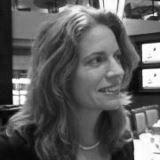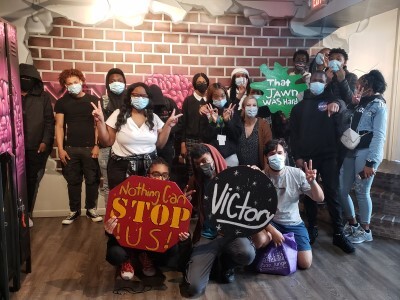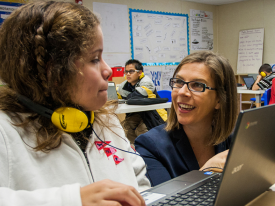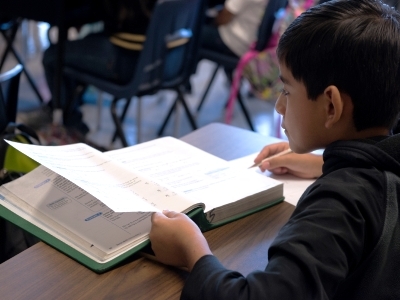Nurturing Seeds of Equity in Next Generation School Design
Topics

Together, educators are doing the reimagining and reinvention work necessary to make true educational equity possible. Student-centered learning advances equity when it values social and emotional growth alongside academic achievement, takes a cultural lens on strengths and competencies, and equips students with the power and skills to address injustice in their schools and communities.
As CityBridge Foundation nurtures the local ecosystem for education in Washington, D.C., Margaret Angell and Caroline Hill are asking, “How might we design for equity?”
Equity is a driving force behind NGLC’s investments in next gen school designs, and Regional Funds for Breakthrough Schools. It’s implicit in our shared goal of preparing every student for college, career, and a lifetime of learning. Lately, we’ve been discussing it more explicitly, and we’re finding a willingness to talk, reflect, and wrestle with diverse and shared understandings about equity matters—maybe more than we initially realized.
Margaret Angell, one of the NGLC Regional Funds partners at CityBridge Foundation in D.C., said about equity recently, “It’s not a part of the work. It is the work.” She meant it’s not an add on, something we attend to when the occasion arises, or when the annual performance data is released. It’s an everyday effort. The CityBridge team is striving to make equity a design principle of schools in a way that challenges our assumptions about students, their communities, and how we build institutions to ensure equitable access to lives of purpose and success.
The regional partners have been incubating next gen schools and carefully tending to the needs of their local learning ecosystems. Like master gardeners, they nurture the siting, seeding, and growth of each plant while caring for the interactions and effects of the garden as a whole. About a year ago, all the partners shared data and progress in their respective “urban gardens.” Some of the data from D.C.provides a context of the garden CityBridge is helping to grow.
Educational Inequity in D.C.
According to Margaret, “D.C. has one of the biggest racial gaps in income in this country, and it’s reflected in our NAEP scores. Over the past decade, while NAEP scores have improved for all, the biggest bumps in performance were for non-low income black students. And despite 20 years of reform, the biggest challenge remains serving and preparing low-income students. We’ve made progress but not the kind that lives up to our aspirations.”
Descriptive Information
- DCPS is a smaller metropolitan system, about 80,000 kids
- 20-year history with ed reform
- School choice (almost even split with 45% charter and 55% district schools)
- Above average per-pupil funding $14,400 plus additional funding from public sector is closer to $17-18,000 per child
- Universal pre-K for children 3 and 4 years old
- Human capital reforms with mayoral control and former Chancellor Rhee established progressive teacher evaluation and compensation contracts with teacher unions
- A talent mecca in education
- Leadership stability, as current Chancellor Henderson formerly worked with Chancellor Rhee for a period of 5 years
Starting the Conversation
In addition to supporting Breakthrough Schools: D.C., CityBridge Foundation also offers an intensive professional learning opportunity for teacher-leaders, the Education Innovation Fellowship. The fellowship is now in it’s third year and 78 (54 alumni, 24 current Fellows) educators strong. Margaret candidly shared that it’s these local D.C. teachers that are changing the conversations about equity. She added, “We just listened. We’re learning so much from them—it’s their passion and vision that resonates.” Maybe in response to the reductionist view of the role of achievement data, or due to wonderings around unrealized gains from accountability systems, these teachers are grappling with what gets talked about and how. What really matters and what happens next.
“We’re thinking more holistically about the system design—all the influencing factors,” Margaret explained. “The Fellows have helped us think bigger, more thoughtfully, and more humanly. It’s about elevating the social-emotional issues and it’s about the conditions and fabric in our communities.”
“And frankly,” she said, “we have more questions than answers, so a big part of the work is being open to and inviting the conversation… acknowledge that income and race are deep structural issues. We asked, how might we design for equity or how might we design by acknowledging the constraint of segregation by income and race? We are designing with these issues in mind and designing for the structures we live in with a desire to improve and alleviate them. We’ve embedded equity as a criteria now in our design and review process. But that’s just one example; the conversation and the pervasiveness of the awareness addressing it is just much more front and center now.” That’s maybe a necessary, and empathetic response, because as Margaret recounted, one Fellow said, “being black is not theoretical, it’s my students’ reality.”
Doing Something About it
Caroline Hill, who was the founding principal of E.L. Haynes high school and who has now joined the CityBridge team to lead the Regional Fund, has also started DC Equity Lab, a stand alone organization run by a community of volunteers who bring design thinking to issues of equity. DC Equity Lab is a 4.0 catalyst organization and is hosting a series of hackathons over the next 12 months in which participants are asked to address different dimensions of equity. The first one tackled college access. Caroline said, “These are issues every community faces but each community must tackle the issues themselves and leverage new solutions against entrenched challenges. DC Equity Lab is just one part of our story, obviously I think it’s poised to play an important role.” You can follow the conversation of the DC Equity Lab hackathons at #1k4equity.
Education Innovation Fellows read several articles as part of their own learning process. Some examples are included below for interested readers.
The very fact that this letter begins with addressing either a man or woman in the office of President of the United States is in itself a cause for celebration and a tribute to the historic nature of this year’s presidential contest. For this we all—regardless of political persuasion—should feel more deeply invested in the promise of democracy to include all Americans regardless of race, class, and gender.
-–Gloria Ladson Billings, A Letter to Our Next President
Schools are a major part of society’s institutional processes for maintaining a relatively stable system of inequality. They contribute to these results by active acceptance and utilization of a dominant set of values, norms and beliefs, which, while appearing to offer opportunities to all, actually support the success of a privileged minority and hinder the efforts and visions of a majority.
–Eugene Eubanks, Ralph Parish, and Dianne Smith, The Nature of Discourse in Schools (T-Chart), and Changing the Discourse in Schools (whole text)
CityBridge will host NGLC grantees for site visits this May where the Education Innovation Fellowship program, Breakthrough Schools: D.C., and other ecosystem efforts—all focused on equity—will be shared more in depth. And, in the months leading up to May, NGLC will continue to invite you into this discussion.
NGLC would like to thank the team at CityBridge Foundation for generously sharing their lessons learned and resources for the benefit of the network.




